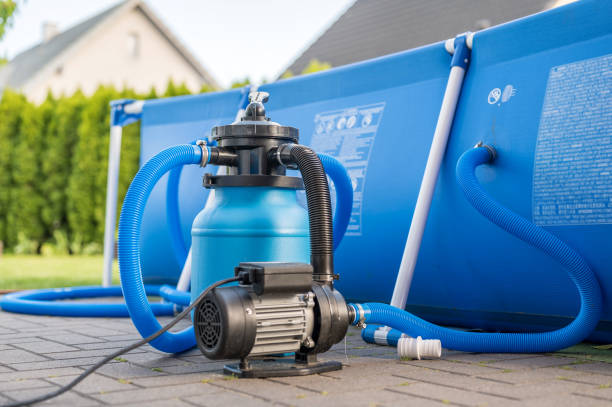A well-maintained pool pump keeps your pool water clean, safe, and ready for that perfect swim, no matter the season. But let’s face it, pool pumps aren’t exactly cheap, and the last thing anyone wants is to spend on a replacement sooner than necessary. Fortunately, a little knowledge and a few proactive steps can help extend the life of your pool pump and keep it running efficiently.
1. Understanding the Role of Your Pool Pump
First, let’s go over why the pool pump matters. Your pool pump isn’t just an accessory; it’s the heart of your pool’s filtration system. It circulates water through filters, ensuring that debris, dirt, and potentially harmful bacteria are removed. Without it, the water would quickly stagnate and become unsanitary. Think of it this way: when the pump is running well, you’re enjoying clean, clear water with minimal fuss. But when it’s struggling or broken down, the cleanliness and safety of your pool can quickly decline.
When your pool pump starts showing signs of wear and tear, it doesn’t just impact your pool’s cleanliness; it can also lead to higher electricity bills, as an inefficient pump needs more power to operate. Spotting issues early and addressing them with professional pool pump repair Melbourne can save money and extend your pump’s lifespan, keeping everything running smoothly.
2. Common Pool Pump Problems (and Why Timing Matters)
Here’s the thing: pool pumps rarely fail all at once. Instead, they often give small hints that something’s off, long before they completely stop working. The trick is knowing what to look for and addressing it in time. Here are some common pool pump problems that, if caught early, can save you from major repairs or even a full replacement:
- Unusual Noise – Rattling, screeching, or humming noises can be a sign of internal issues like worn bearings or an impeller that needs cleaning.
- Loss of Pressure – If the pump isn’t moving water as forcefully as before, there might be a blockage, a leak, or a problem with the impeller.
- Frequent Tripping of the Circuit Breaker – This can signal an electrical issue within the motor, often a result of overheating or moisture inside the pump’s motor compartment.
- Leaking Pump – A leak around the pump housing can signal a failing seal, which is both easy and inexpensive to replace if caught early.
- Overheating – If the pump is running hot to the touch, it may be struggling with poor ventilation or blockages, which can lead to motor failure over time.
Addressing these issues as soon as they pop up isn’t just about fixing an inconvenience; it’s about protecting your investment. A timely repair can often be a quick and affordable fix, while waiting too long could mean needing a whole new pump.
3. Key Maintenance Tips for a Long-Lasting Pool Pump
While timely repairs are essential, regular maintenance also plays a significant role in extending the life of your pool pump. Here are some key maintenance steps to follow:
Contents
Keep the Area Around the Pump Clear
Your pool pump needs room to breathe. If debris or leaves build up around the pump, it can cause ventilation issues and overheating. Make sure to clear away any obstructions and maintain a clean environment around the pump for optimal airflow.
Check and Clean the Strainer Basket Regularly
Your pool pump’s strainer basket collects debris to prevent it from entering the pump. If this basket becomes too full, it can strain the pump motor. Cleaning it out once a week helps maintain steady water flow and reduces unnecessary wear on the pump.
Monitor and Adjust Water Levels
A pool pump relies on proper water levels to function efficiently. Low water levels can cause the pump to run dry, damaging its motor. Keep an eye on water levels, especially during hot weather, and add water when needed to keep things running smoothly.
Backwash the Filter
If your filter is clogged, your pump has to work harder, which can wear it out prematurely. Regular backwashing or cleaning of the filter reduces pressure on the pump and allows it to work efficiently. Make sure to follow the manufacturer’s instructions on how often to do this.
Schedule an Annual Professional Inspection
Even if everything seems fine, having a professional check your pump once a year can be a wise investment. They can spot minor issues you might miss, helping you avoid potential breakdowns and extend the life of your pump.
4. Knowing When to Repair vs. Replace
As much as timely repairs can work wonders, every pool pump has a lifespan, and knowing when to let it go is part of good maintenance. If your pump is over seven to ten years old and requires constant repairs, it might be time to weigh up the costs of ongoing repairs against getting a new, more efficient model. A new pump may offer energy savings, quieter operation, and more advanced technology that makes pool care easier in the long run.
If you’re not sure whether to repair or replace, consider consulting a professional who can assess the pump’s condition. They can help you evaluate whether the pump is worth saving or if you’d benefit from the upgrade to a newer model.
Get More Years Out of Your Pool Pump
A pool pump isn’t something most people think about every day, but giving it a little attention when needed can make all the difference. By staying alert to early signs of wear, performing regular maintenance, and knowing when to call for repairs, you can keep your pump running efficiently for years. Taking these simple steps not only extends the pump’s lifespan but also keeps your pool in top shape and helps you avoid unnecessary expenses. After all, a well-maintained pump means less worry, more swimming, and a pool that’s ready whenever you are.

